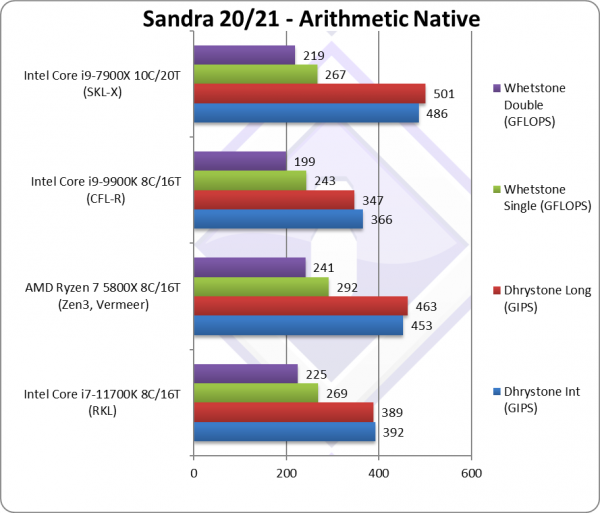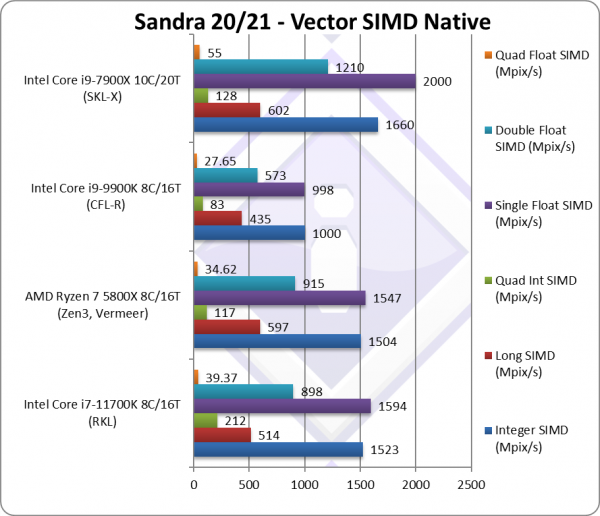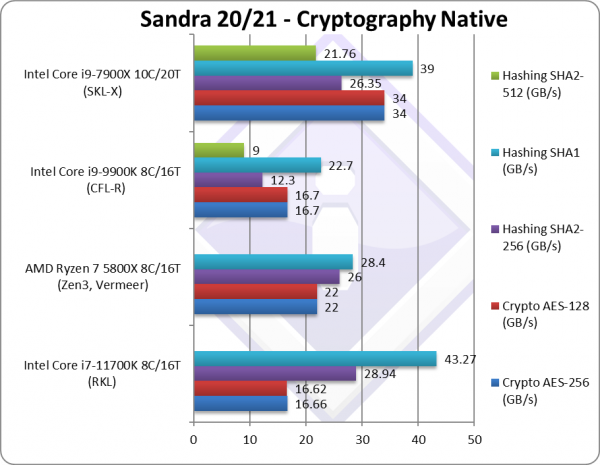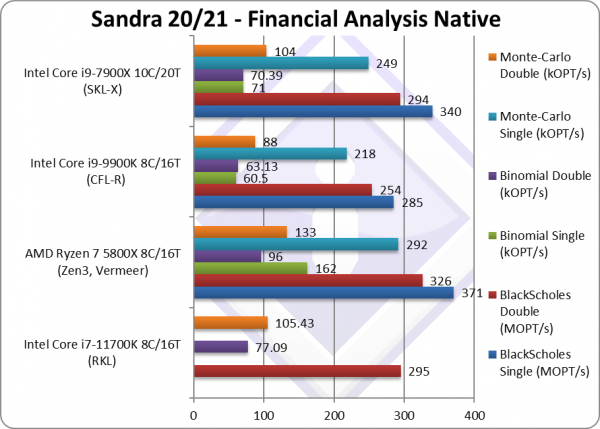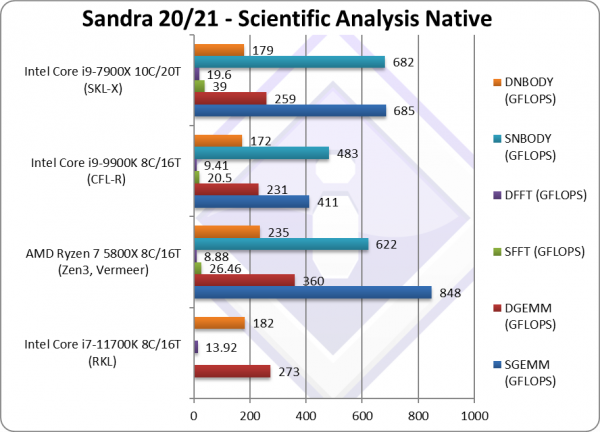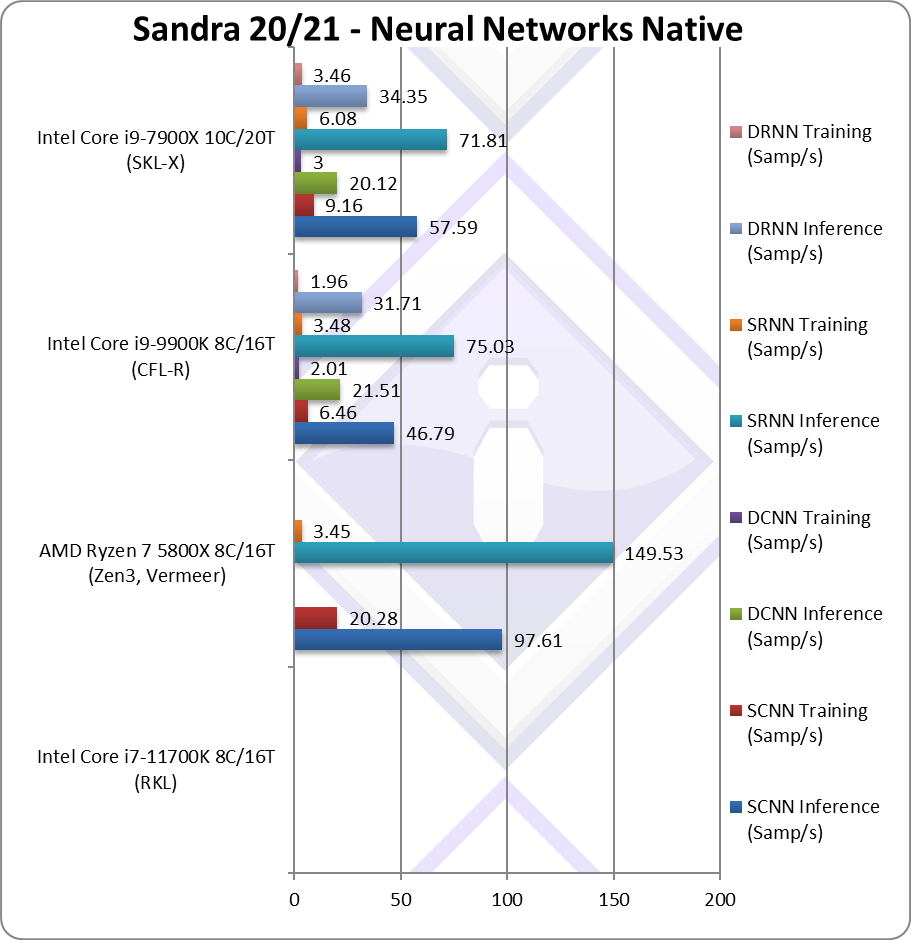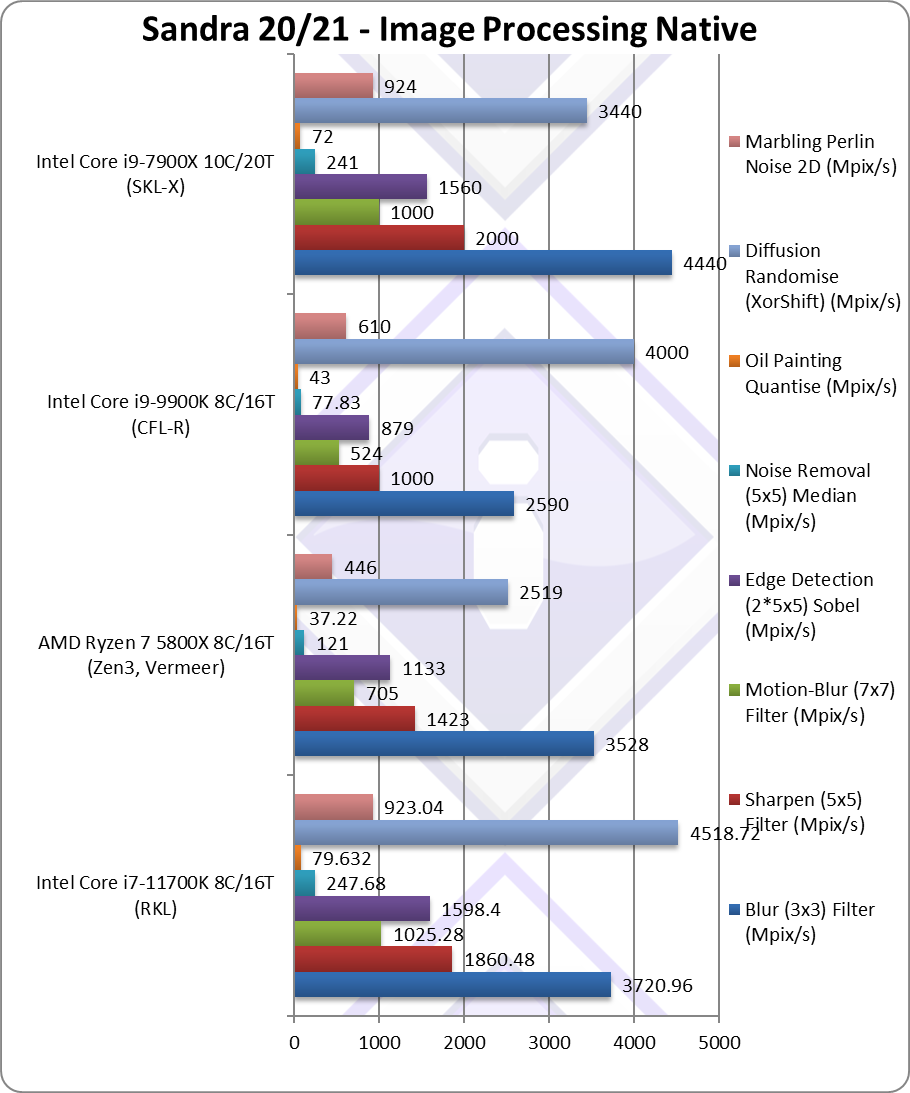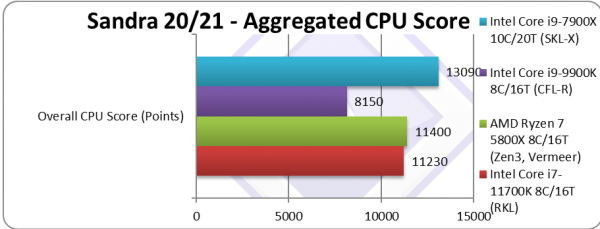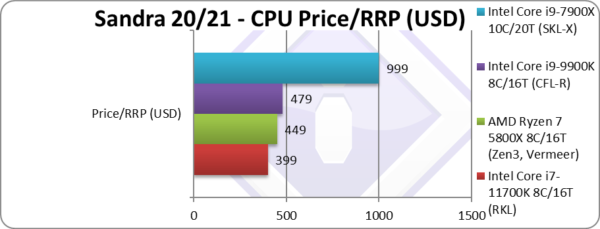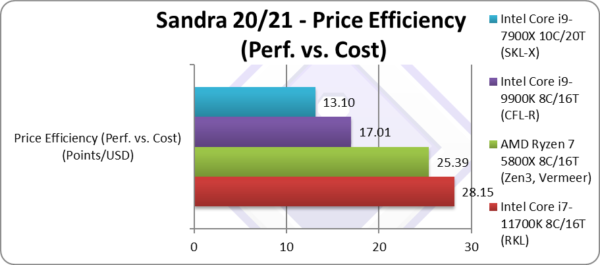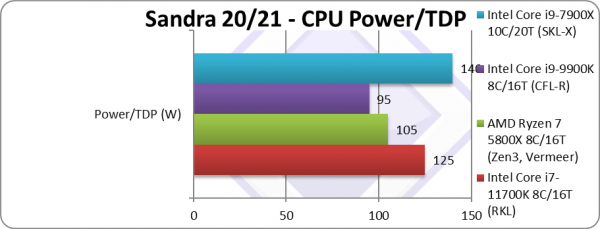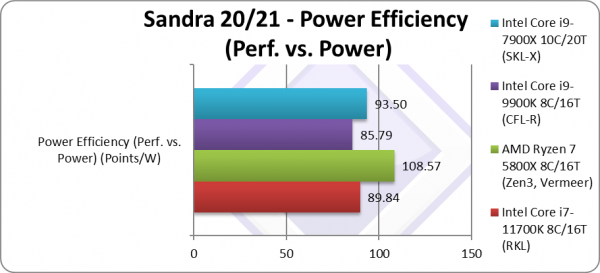What is “RocketLake”?
It is the desktop/workstation version of the true “next generation” Core (gen 10+) architecture – finally replacing the ageing “Skylake (SKL)” arch and its many derivatives that are still with us (“CometLake (CML)”, etc.). It is a combination of the “IceLake (ICL)” CPU cores launched about a year go and the “TigerLake (TGL)” Gen12 XE graphics cores launched recently.
With the new core we get a plethora of new features – some previously only available on HEDT platform (AVX512 and its many friends), improved L1/L2 caches, improved memory controller and PCIe 4.0 buses. Sadly Intel had to back-port the older ICL (not TGL) cores to 14nm – we shall have to wait for future (desktop) processors “AlderLake (ADL)” to see 10nm on the desktop…
- 14nm+++ improved process (not 10nm)
- Up to 8C/16T “Cypress Cove” cores aka 14nm+++ “Sunny Cove” from ICL – Claimed core IPC uplift of +19%
- AVX512 and all of its friends (1x FMA Unit)
- Increased L1D cache to 48kB (50% larger)
- Increased L2 cache to 512MB (2x as large)
- PCIe 4.0 (up to 32GB/s with x16 lanes) – 20 (16+4 or 8+8+4) lanes
- Thunderbolt 3 (and thus USB 3.2 2×2 support @ 20Gbps) integrated
- Hardware fixes/mitigations for vulnerabilities (“JCC”, “Meltdown”, “MDS”, various “Spectre” types)
The biggest change is support for AVX512-family instruction set, effectively doubling SIMD processing width (vs. AVX2/FMA) as well as adding a whole host of specialised instructions that even the HEDT platform (SKL/KBL-X) does not support yet:
- AVX512-VNNI (Vector Neural Network Instructions, dlBoost FP16/INT8) e.g. convolution
- AVX512-VBMI, VBMI2 (Vector Byte Manipulation Instructions) various use
- AVX512-BITALG (Bit Algorithms) various use
- AVX512-VAES (Vector AES) accelerating block-crypto
- AVX512-GFNI (Galois Field) – e.g. used in AES-GCM
- SHA HWA accelerating hashing (SHA1, SHA2-256 only)
While some software may not have been updated to AVX512 as it was reserved for HEDT/Servers, due to this mainstream launch you can pretty much guarantee that just about all vectorised algorithms (already ported to AVX2/FMA) will soon be ported over. VNNI, IFMA, etc. support can accelerate low-precision neural-networks that are likely to be used on mobile platforms.
The caches are finally getting updated and increased considering that the competition has deployed massively big caches in its latest products. L1D is 50% larger and L2 doubles (2x) but L3 has not been increased. We will measure latencies in a future article.
From a security point-of-view, RKL mitigates all (current/reported) vulnerabilities in hardware/firmware (Spectre 2, 3/a, 4; L1TF, MDS, etc.) except BCB (Spectre V1 that does not have a hardware solution) thus should not require slower mitigations that affect performance (especially I/O). RKL is also not affected by the JCC errata that needs mitigatation through software (compiler) changes on older processors.
The memory controller supports higher DDR4 speeds (up to 3200Mt/s) while the cache/TLB systems have been improved that should help both CPU and GPU performance (see corresponding article) as well as reduce power vs. older designs using LP-DDR3. Again we will measure bandwidth and latencies in a future article.
PCIe 4.0 finally arrives on Intel and should drive wide adoption for both discrete graphics (GP-GPUs including Intel’s) and NVMe SSDs with ~8GB/s transfer (x4 lanes) and to ~32GB/s (x16). Note that the DMI/OPI link between CPU and I/O Hub is also thus updated to PCIe 4.0 speeds improving CPU/Hub transfer.
On the desktop – while the Intel is launching new 500-series motherboards, RKL should be compatible with 400-series boards with a BIOS update. Just as with AMD, PCIe 4.0 may only be available on 500-series boards.
Finally the GPU cores have been updated to XE (Gen 12) cores, up to 96 on some SKUs that represent huge compute and graphics performance increases over the old (Gen 9.x) cores used by gen 10 APUs (see corresponding article).
CPU (Core) Performance Benchmarking
In this article we test CPU core performance; please see our other articles on:
- CPU
- Intel 12th Gen Core AlderLake (i9-12900K) Review & Benchmarks – big/LITTLE Performance
- Intel 11th Gen Core RocketLake AVX512 Performance Improvement vs AVX2/FMA3
- Intel 11th Gen Core RocketLake (i9-11900K) Review & Benchmarks – CPU AVX512 Performance
- Intel Core Gen 10 IceLake ULV (i7-1065G7) Review & Benchmarks – CPU AVX512 Performance
- Cache & Memory
- GPGPU
- Intel Iris Gen 12 Rocketlake (i7-11700K) Review & Benchmarks – GPGPU Performance
- Intel DG1 (Iris Xe Max Gen12) Review & Benchmarks – GPGPU Performance
- Intel Iris Plus G7 Gen 12 XE TigerLake ULV (i7-1165G7) Review & Benchmarks – GPGPU Performance
- Intel Iris Plus G7 Gen 11 IceLake ULV (i7-1065G7) Review & Benchmarks – GPGPU Performance
Hardware Specifications
We are comparing the top-of-the-range Intel with competing architectures as well as competiors (AMD) with a view to upgrading to a mid-range but high performance design.
| Specifications | Intel i7 11700K 8C/16T (RKL) | AMD Ryzen 7 5800X 8C/16T (Zen3) | Intel i9 9900K 8C/16T (CFL-R) | Intel i9 7900X 10C/20T (SKL-X) | Comments | |
| Arch(itecture) | Cypress Cove / RocketLake | Zen3 / Vermeer | CoffeeLake Refresh | Skylake-X | Not the very latest arch. | |
| Cores (CU) / Threads (SP) | 8C / 16T [=] | 2M / 8C / 16T | 8C / 16T | 10C / 16T | No change in cores count. | |
| Rated Speed (GHz) | 3.6 [=] | 3.8 | 3.6 | 3.3 | Same base clock. | |
| All/Single Turbo Speed (GHz) |
4.6 – 5.0 [=] | 4.5 – 4.8 | 4.7 – 5 | 4.0 – 4.3 | Same single-core turbo. | |
| Power TDP/Turbo (W) |
125 – 175 | 105 – 135 | 95 – 135 | 140 – 308 | TDP seems 25% over CFL. | |
| L1D / L1I Caches | 8x 48kB 12-way [+50%] / 8x 32kB 8-way | 8x 32kB 8-way / 8x 32kB 8-way | 8x 32kB 8-way / 8x 32kB 8-way | 10x 32kB 8-way / 10x 32kB 8-way | L1D is 50% larger. | |
| L2 Caches | 8x 512kB 16-way [2x] | 8x 512kB 16-way | 8x 256B 16-way | 10x 1MB 16-way | L2 has doubled. | |
| L3 Caches | 16MB 16-way [=] | 32MB 16-way | 16MB 16-way | 13.75MB 11-way | L3 is the same | |
| Microcode (Firmware) | 06A701-2C* (ver 44*) |
8F7100-21 (ver 33) | 069E0C-D6 (ver 214) | 065504-69 (ver 105) | Revisions just keep on coming. | |
| Special Instruction Sets |
AVX512, VNNI, SHA, VAES | AVX2/FMA, SHA | AVX2/FMA | AVX512 | More AVX512! | |
| SIMD Width / Units |
512-bit (1x FMA Unit) |
256-bit | 256-bit | 512-bit (2x FMA Units) |
Widest SIMD units, but single FMA. | |
| Price / RRP (USD) |
$399 [-17%] |
$449 | $479 | $999 |
Cheapest launch i7? | |
Disclaimer
This is an independent review (critical appraisal) that has not been endorsed nor sponsored by any entity (e.g. Intel, etc.). All trademarks acknowledged and used for identification only under fair use.
The review contains only public information and not provided under NDA nor embargoed. At publication time, the products have not been directly tested by SiSoftware but submitted to the public Benchmark Ranker; thus the accuracy of the benchmark scores cannot be verified, however, they appear consistent and pass current validation checks.
Native Performance
We are testing native arithmetic, SIMD and cryptography performance using the highest performing instruction sets. “Rocketlake” (RKL) supports all modern instruction sets including AVX512, VNNI, SHA HWA, VAES and naturally the older AVX2/FMA, AES HWA.
Results Interpretation: Higher values (GOPS, MB/s, etc.) mean better performance.
Environment: Windows 10 x64, latest AMD and Intel drivers. 2MB “large pages” were enabled and in use. Turbo / Boost was enabled on all configurations.
Note: The microcode (aka CPU firmware) used in the test as per above is version 2C (version 44); older or newer versions (e.g. 34, 39, etc.) seem to exhibit different performance. We will update the review when we obtain our sample and run our own tests.
Across SIMD tests, we see RKL with AVX512 about 40% faster than old CFL-R with the same number of cores (8C / 16T). Thus RKL also beats the older HEDT SKL-X with more cores (7900X 10C / 20T and 2x FMA units) and thus top-range CML (10900K 10C / 20T). But it cannot always win against Ryzen3 5800X (also 8C / 16T) with the winner changing across a variety of tests.
SiSoftware Official Ranker Scores
- 11th Gen Intel Core i9-11900K (8C / 16T, 5.3GHz)
- 11th Gen Intel Core i7-11700K (8C / 16T, 3.6GHz)
- 11th Gen Intel Core i7-11700 (8C / 16T, 2.5GHz)
- 11th Gen Intel Core i5-11600 (6C / 12T, 4.8GHz)
Final Thoughts / Conclusions
Summary: A long over-due upgrade (~40% SIMD/AVX512 improvement) : 8.5/10
Note2: The microcode (aka CPU firmware) used in the test as per above is version 2C (version 44); older or newer versions seem to exhibit different performance. We will update the review when we obtain our sample and run our own tests.
Note3: All benchmarks run are using the latest supported instruction sets – i.e. AVX512; Sandra does allow you to disable it and run AVX2/FMA3 or even AVX, SSE4, SSE2. Once we get our sample we will show the results using AVX2/FMA3.
We’ve really been waiting way too long for this – endless Skylake (SKL) derivatives (Gen 6, 7, 8, 9 and 10) then finally IceLake (ICL) and TigerLake (TGL) but for mobile (ULV) only. RocketLake (RKL) is not quite what we expected, as it’s not on 10nm and also using the older ICL cores (not TGL), but at least compatible with the 400-series (LGA 1200) platform. With AMD making steady improvements with Ryzen (series 2000, 3000 and now 5000), the top end i9 10900K CometLake (CML) could not really keep up: we really needed a new contender from Intel.
RocketLake (RKL) i7 (11700K) does not increase number of cores (still 8C / 16T), nor speeds (rated / turbo), but AVX512 + arch improvements (IPC, larger caches, TLBs, etc.) make it about 40% faster than CFL/CML and with optimisations (and higher speed memory) likely higher. TDP (Power) is higher at 125W and being still at 14nm RKL will need a lot more (155W+) to maintain top clocks.
Existing 400-series boards should also support RKL after a BIOS update, but likely no PCIe 4.0 (as we had with AMD Ryzen 3000/5000 and 400-series boards). Still best to get a 500-series board for best support which does add to the cost.
We have been waiting for PCIe 4.0, already supported by AMD 2 generations ago, and by now by modern GP-GPUs and NVMe SSDs; perhaps not quite needed, but with mass-market gaming consoles (Sony PS5, Microsoft XBox SS/XS) using NVMe/PCIe4 storage – it became a bit of an embarrassment for top-end PCs to lack it.
We also get native USB 3.2 2×2 at 20Gbps and Thunderbolt 3 (depending on the board) which can greatly help both external storage (especially NVMe or RAID arrays) and even network connection (through Thunderbolt) faster than the meagre 1Gbps (Gigabit) Ethernet… [note some boards include 2.5Gbps Ethernet, but sadly not all]
We have not touched on the Iris Gen12 XE graphics which is a *big* upgrade over the really old EV9.x graphics (see the corresponding review). However, while the TGL 96EU versions are pretty powerful – the gimped 32 EU versions will be limited: but at least i7, i9 versions are likely to be paired with a dedicated graphics card.
The keen pricing ($399) and good performance do make it a good choice for both upgraders (with 400-series boards) and those that want to “future-proof” by choosing a CPU with the latest technologies. With updated software and support, performance will only get better and hopefully the price reduce even further – making the i7 (11700K) great value for money.
Summary: Recommended : 8.5/10
The Future: AlderLake (ADL) Hybrid (big.LITTLE)
As we have seen in our TigerLake (TGL) benchmarks, TGL improves significantly over ICL (and thus RKL using the same cores at 14nm) – thus 10nm ADL “big Core” is likely to be much faster than RKL and at much lower power. So if it all goes to plan, ADL will be the Core we are all looking for…
However, ADL is a hybrid processor, consisting of “big Core” cores + “LITTLE Atom” cores – and these kind of hybrid architectures are a massive pain in the proverbial for (software) developers. There is a massive work being done underneath the hood in Sandra to support such hybrid architecture (detection/scheduler/benchmarks/UI) and it will live and die based on how good the Windows scheduler will manage cores. The future will certainly be interesting…
Further Articles
Please see our other articles on:
- CPU
- Intel 12th Gen Core AlderLake (i9-12900K) Review & Benchmarks – big/LITTLE Performance
- Intel 11th Gen Core RocketLake AVX512 Performance Improvement vs AVX2/FMA3
- Intel 11th Gen Core RocketLake (i9-11900K) Review & Benchmarks – CPU AVX512 Performance
- Intel Core Gen 10 IceLake ULV (i7-1065G7) Review & Benchmarks – CPU AVX512 Performance
- Cache & Memory
- GPGPU
- Intel Iris Gen 12 Rocketlake (i7-11700K) Review & Benchmarks – GPGPU Performance
- Intel DG1 (Iris Xe Max Gen12) Review & Benchmarks – GPGPU Performance
- Intel Iris Plus G7 Gen 12 XE TigerLake ULV (i7-1165G7) Review & Benchmarks – GPGPU Performance
- Intel Iris Plus G7 Gen 11 IceLake ULV (i7-1065G7) Review & Benchmarks – GPGPU Performance
Disclaimer
This is an independent review (critical appraisal) that has not been endorsed nor sponsored by any entity (e.g. Intel, etc.). All trademarks acknowledged and used for identification only under fair use.
The review contains only public information and not provided under NDA nor embargoed. At publication time, the products have not been directly tested by SiSoftware but submitted to the public Benchmark Ranker; thus the accuracy of the benchmark scores cannot be verified, however, they appear consistent and pass current validation checks.

